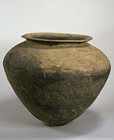Japanese Archaeology and Special Exhibition (Heiseikan) Thematic Exhibition Room
December 8, 2009 (Tue) - March 7, 2010 (Sun)
Ibaraki prefecture, located to the north-east of Tokyo, boasts a rich natural environment. It overlooks the Pacific Ocean to the east, is flanked by mountains to the north and north-west and is bordered to the south by the Tonegawa river. Its Kasumigaura area is also the center of an expansive lake district. People began to dwell in these lands from Palaeolithic times and plenty of archaeological sites remain, including many shell middens and kofun tumuli, or burial mounds.
Under the ancient ritsuryo system of centralized government and fixed law, Ibaraki held an important position as the main gateway for traffic through to the northeastern Tohoku region. The Oda, Daijo, Satake and other such warrior clans flourished in Ibaraki in the middle ages.
This exhibition features artifacts excavated from Ibaraki prefecture. These include objects excavated from sutra mounds, created to preserve sutras for future generations and to pray for rebirth in the Buddhist Pure Land, as well as ritual steles from the middle ages and domestically produced bronze mirrors.
Presented as part of the Tokyo National Museum's annual archaeological objects exchange program, this exhibition showcases objects on loan from Ibaraki Prefectural Museum of History in addition to selections from the Tokyo National Museum collection.

